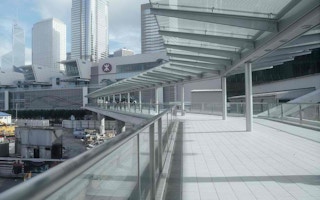Greg Pearce, a licensed architect in the United Kingdom and Hong Kong, is a well known interdisciplinary designer in the former British colony. He is an accomplished author, lecturer, and furniture designer, aside from being a commercial interior design specialist advocating sustainability principles.
To continue reading, subscribe to Eco‑Business.
There's something for everyone. We offer a range of subscription plans.
- Access our stories and receive our Insights Weekly newsletter with the free EB Member plan.
- Unlock unlimited access to our content and archive with EB Circle.
- Publish your content with EB Premium.
Throughout his varied creative pursuits, he consistently emphasises the importance of practicality in design. As such, this maxim became the cornerstone of an integrated design firm he helped establish in 2004, called One Space Limited. Its aim is to incorporate efficiency and environmental consciousness in every step of the design process, particularly in maximising limited spaces and reducing the use of energy and other resouces. Pearce said this is largely influenced by the ‘unique’ constraints of Hong Kong, one of the most compact cities in Asia.
This approach enables businesses and organisations to boost their performance while reducing their operational footprint, he added. His first project in Hong Kong, the Hong Kong Central Station, demonstrates this. Its design uses ‘wells of natural light’ and is based on passenger orientation.
Pearce, who came to Hong Kong as the principal architect of the design team from Arup in London, chronicled the design and construction process of the project in a book entitled Arup, Hong Kong Station. It details how a major piece of infrastructure was carefully integrated into the city landscape.
Pearce will be sharing his design experience and guiding principles as one of the international speakers at the Macao International Environmental Co-operation Forum and Exhibition (MIECF), which starts on March 27 up to March 29. Prior to his talk on the future of smart building design and environment-friendly commercial interior designs in Asia, he shares with Eco-Business how his sensitivity to sustainable design emerged early during his formative years and how authenticity is tied to design and the future of Asian cities, including Hong Kong.
When and how did sustainable design become part of your practice? What inspired you to apply sustainability in your approach?
I vividly recall the first book I read on architecture when I was about 11 and it was about what we now classify as ‘sustainable house design’. What struck me from this book at that age is that an architect has an inescapable duty to the environment. In a way, I could say sustainable design principles were at the core foundation of my learning.
Apart from that, I started studying architecture more than 40 years ago in the United States, where I was exposed to an era when peace advocates were becoming more conscious with environmental issues. During that period, the global fossil fuel crisis of the 1970s had made a deep impact in the public’s consciousness, and soon, every young person then was talking about a way of life which we now call as ‘sustainability’. It was during these turbulent times when I began my life journey in architecture.
You initially went to Hong Kong to establish a branch office for British firm Arup Associates in 1992. What made you stay in Hong Kong? Is this a city you would call liveable or sustainable?
Hong Kong is one of the densest urban environments on the planet, which makes it an exhilarating place to live and work in. I fell in love quite quickly with its ‘can do’ practicality, inexhaustible energy, admirable resiliency and unparalleled industriousness.

Award-winning architect Greg Pearce, co-founder of One Space Limited is an advocate of interdisciplinary design. Image: One Space
In my view, Hong Kong’s sustainability potential is very high. In urban planning, it can be called a classic ‘compact city’. Although its total land area is about 1,050 square kilometres, only about 25 per cent of this is developed, and still about 42 per cent of the total land area is dedicated to nature reserves and country parks, which is one of the largest allocations in the world.
However, air quality, waste management and other environmental challenges are affecting Hong Kong’s ‘liveability’.
What should Hong Kong do to address these issues and how do you tackle these issues in your design projects?
I believe that Hong Kong’s sustainable future will be very much dependent on the government’s willingness and ability to devise and implement more holistic and forward-looking policies, such as in land-use planning, urban quality-of-life, environmental heritage protection and social welfare.
Currently, the space limitation puts pressure on real estate prices. At One Space, the drive to make our clients’ property expenditures deliver as much benefit as possible per square foot is perhaps the single strongest driver for our creativity. Our design process is highly practical and requirements-driven. We always begin a project with a strategic study to ensure that the design solution supports our client’s business case.
Apart from that, small spaces also profoundly influence the way Hong Kong people live and work. In fact, I would suggest, it affects our perception of space at a very basic level of human experience. So at One Space, we embrace this peculiar Hong Kong phenomenon. The interiors we design in Hong Kong belong to its unique culture.
With this space limitation, how do you design environmentally friendly commercial interiors? And what examples of these will you share at MIECF?
I believe that truly honest sustainability arises from a holistic approach, infusing every step of the design process with a mind-set that seeks to optimise the use of resources towards attaining a clearly defined business objective.
Too often, designers focus on solutions that look environmental or products that have a captivating environmental story behind them, instead of engaging in the more difficult task of reducing materials or energy expenditure.
At the MIECF, I will share some of our experiences designing commercial interiors in Hong Kong’s rich, yet space-constrained, urban context. Optimising our clients’ space – that is, minimising the footprint of their business operations – is the first and most valuable contribution an interior architect can do to help them achieve sustainable design.
Our clients include HSBC, Bank of China, Louis Vuitton and Standard Chartered Bank, and other multinational organisations. This diverse portfolio of clients has one thing in common – they believe that good design can make a difference to their business, to the environment and to the welfare of their staff.
Socially and environmentally conscious designs come in different forms and names these days, such as impact design, smart design or public interest design. How would you differentiate yours?
The core tenet of One Space’s work is authenticity. This fundamental principle demands integrity at every step of our process. Authentic design in true to itself, loyal to its origins and adapts itself solely to meet its purpose.
For us, sustainability is part of the same mindset that anchors us to authenticity. Wastefulness arises when design deviates from its purpose or engages in folly. When decision-making becomes willful, the squandering of valuable resources is sure to follow. Sustainable design embraces constraints and limits its reach to solve the problem at hand in as efficient a form as possible.
“
For us, sustainability is part of the same mindset that anchors us to authenticity. Wastefulness arises when design deviates from its purpose or engages in folly … Sustainable design embraces constraints and limits its reach to solve the problem at hand in as efficient a form as possible
Greg Pearce, managing director of One Space Ltd
It’s also important to remember that sustainability is a three-pronged principle – economic, social and environmental – and that the entire life cycle of a project should embody this aim. For example, our designers are concerned as much about the labour conditions at the production stage of the project life cycle as they are about the health and safety of the end-users at the other end of the cycle.
The University of Hong Kong’s Faculty of Architecture started an interdisciplinary programme under your direction in 2002. Why is an interdisciplinary approach important in sustainability?
In 2000, the University of Hong Kong approached me to design, establish and then direct the first interdisciplinary collaboration master degree programme for the design and construction industry in Asia. We dubbed it ‘MIDM – Master of Interdisciplinary Design and Management’ and it became well-enrolled by major corporate and government players in the industry. I directed the programme until 2005.
Government-led research found that endemic shortcomings in interdisciplinary teamwork were at the root of many environmental and quality issues faced at that time in Hong Kong. Specifically, construction waste was and is a significant problem for us, and much of this waste was found to have emanated not from technical or process issues, but from inadequate or ill-directed teamwork, perhaps as early as at the briefing and design stages. Sustaining innate patterns of interdisciplinary teamwork remain a long-range aim.
In my own practice, interdisciplinarity is a core part of our successes. When I established One Space, I partnered not with a fellow architect, but with a technology expert. We felt that an interdisciplinary approach to commercial interiors was missing in the market and would be valued by businesses – and it turns out we were right! One outcome of this is that we are inherently curious, searching always beyond the ‘obvious’ answers. Our design creativity arises from this attribute.
Talking about foresight, what will be the major considerations for the built environment in Asia in the coming years?
Southeast Asia is now coping with the greatest wave of urbanisation in the history of civilisation. As of 2008, more than half of the world’s population lives in cities, and by 2050 this is estimated to reach nearly two-thirds of the population. Heightened demand on already scarce natural resources will define how we cope with this paradigm-shifting phenomenon.
Asia will feel the true brunt of this change, and we are as yet ill-equipped to deal with this. It is probably still beyond our understanding what sort of social, environmental and economic changes this will bring. The challenge for us built-environment professionals will be how to continue to design for not only the physical and biological needs of humanity, but for our spiritual needs as well.
Urbanism, a concept that is beyond conventional city planning, must rise to this challenge – to fulfill the ultimate goal of cities, which is to connect people to each other. Cities can continue to be beautiful, highly functioning organisms, or they can become soulless repositories for the mundane, daily functions of human life. As an architect, this concerns me greatly.
To learn more of Greg Pearce and other renowned speakers such as Joseph Stiglitz, American economist and recipient of the Nobel Memorial Prize in Economic Sciences, and James Jao, chief executive of the Long On Group, visit the Macao International Environmental Co-operation Forum & Exhibition (MIECF) held from 27-29 March 2014.
With an exciting lineup of an international conference, exhibition, business matching and networking activities, MIECF offers access to opportunities from the Pan-Pearl River Delta Region of China (PPRD Region), Asia-Pacific and Portuguese-speaking countries and beyond.










